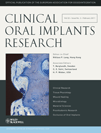Corrigenda
In Truninger et al. (2011), the number of patients in the test group and control group are incorrect on Pages 20 and 21. The correct number of patients in the test group is 13 and in the control group, 16.
The authors would like to apologize for the errors.
Reference
Truninger TC, Philipp AOH, Siegenthaler DW, Roos M, Hämmerle CHF, Jung RE (2011). A prospective, controlled clinical trial evaluating the clinical and radiological outcome after 3 years of immediately placed implants in sockets exhibiting periapical pathology. Clinical Oral Implants Research 22: 20–27. doi: 10.1111/j.1600-0501.2010.01973.x
In Pramstraller et al. (2011), the following errors were published:
Page 54, Abstract:
Results: … (iv) the proportion of sites with BH≥8 mm and BW1 mm≥6 mm was 86.7%, 59.2%, 19.8% and 34.8% at first premolar, second premolar, first molar and second molar sites, respectively.
The values were incorrect and should have read:
Results: … (iv) the proportion of sites with BH≥8 mm and BW1 mm≥6 mm was 28.3%, 18.4%, 8.0% and 18.2% at first premolar, second premolar, first molar and second molar sites, respectively.
Page 54, Abstract:
Conclusions: The results of the study indicate that at second premolar as well as molar sites, the dimensions of the alveolar crest may call for bone augmentation procedures for proper implant placement in a substantial amount of edentulous patients.
The text was incorrect and should have read:
Conclusions: The results of the study indicate that at premolar and molar sites, the dimensions of the alveolar crest may call for bone augmentation procedures for proper implant placement in a substantial amount of edentulous patients.
Page 58, Results, BW section:
BH≥8 mm and BW1 mm≥6 mm was observed in 86.7% (52/60), 59.2% (74/125), 19.8% (32/162) and 34.8% (46/132) of first premolar, second premolar, first molar and second molar sites, respectively.
The values were incorrect and should have read:
BH≥8 mm and BW1 mm≥6 mm was observed in 28.3% (17/60), 18.4% (23/125), 8.0% (13/162) and 18.2% (24/132) of first premolar, second premolar, first molar and second molar sites, respectively.
Page 59, Discussion:
… and (iv) the proportion of sites with BH≥8 mm and BW1 mm≥6 mm was 86.7%, 59.2%, 19.8% and 34.8% at first premolar, second premolar, first molar and second molar sites, respectively.
The text was incorrect and should have read:
… and (iv) the proportion of sites with BH≥8 mm and BW1 mm≥6 mm was 28.3%, 18.4%, 8.0% and 18.2% at first premolar, second premolar, first molar and second molar sites, respectively.
Page 61, Discussion:
In conclusion, the results of the study indicate that at the second premolar as well as molar sites, the dimensions of the alveolar crest may call for bone augmentation procedures for proper implant placement in a substantial amount of edentulous patients.
The text was incorrect and should have read:
In conclusion, the results of the study indicate that at premolar and molar sites, the dimensions of the alveolar crest may call for bone augmentation procedures for proper implant placement in a substantial amount of edentulous patients.
The authors would like to apologize for the errors.
References
Pramstraller M, Farina R, Franceschetti G, Pramstraller C, Trombelli L (2011). Ridge dimensions of the edentulous posterior maxilla: a retrospective analysis of a cohort of 127 patients using computerized tomography data. Clinical Oral Implants Research 22: 54–61. doi: 10.1111/j.1600-0501.2010.01984.x




